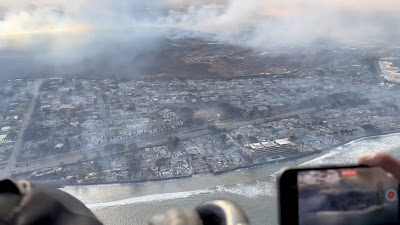The extreme weather across the continent this summer has destroyed huge amounts of land, forced many to evacuate, and in some cases caused deaths.
Dropping water over a fire in Apesia, southern Cyprus, on Monday.Credit...Philippos Christou/Associated Press
By Emma Bubola
Aug. 8, 2023
Floods, fires and heavy rains have landed more blows across Europe this week, with the authorities on the continent scrambling to respond to the extreme weather that has become increasingly common in the past few years.
The most recent events have destroyed large amounts of land, left dozens of people injured, forced thousands to evacuate and, in some cases, caused deaths, and they come on the heels of scorching temperatures that have engulfed much of Southern Europe this summer.
Climate change has made extreme heat a fixture of the warmer months in Europe, but experts say that the continent has failed to significantly adapt to the hotter conditions. Governments in many countries are now struggling to address the devastating effects.
“The extreme weather conditions across Europe continue to be of concern,” Roberta Metsola, the president of the European Parliament, wrote on the social media platform X, formerly known as Twitter. “The EU is showing solidarity with all those in need.”
Deadly Floods in Slovenia
Heavy rains in recent days have led rivers to overflow across Slovenia in what the authorities there said was the worst natural disaster since the country’s independence in 1991.
At least six people have died, according to the Slovenian news agency STA, and thousands have been forced to flee their homes to escape the floods.
Several countries have tried to help, with France and Germany sending equipment such as prefabricated bridges, and even Ukraine, in the middle of a war with Russia, promising to send a helicopter.
A flooded area in the northern Slovenian town of Crna na Koroskem on Sunday.
Entire villages have been left underwater, and huge rivers of mud have filled roads and sports fields and flowed below collapsed bridges, with cars stuck in the debris of landslides caused by the flooding.
Ursula von der Leyen, head of the European Commission, the European Union’s executive arm, said she would travel to Slovenia on Wednesday.
Floods have also been reported in Austria, Slovenia’s northern neighbor, killing at least one person, according to the Austrian chancellor, Karl Nehammer.
Wildfires in Cyprus, Italy and Portugal
Hundreds of firefighters were continuing to battle rural wildfires in Portugal on Tuesday. The blazes have prompted the evacuation of more than a thousand locals and tourists, and several firefighters have been injured while tackling the flames.
The risk of fire in the past few days was at the highest level in large parts of the country, with strong winds and temperatures above 104 degrees Fahrenheit.
Portugal has struggled with wildfires various times in recent years. Blazes killed more than 60 people in 2017.
A tractor cleaning up land during a wildfire in Aljezur, Portugal, on Monday.Credit...Pedro Nunes/Reuters
Elsewhere, the European Union has sent firefighting planes to assist with efforts to tackle wildfires burning on Cyprus in recent days; Greece, which has also been plagued by wildfires this summer, has sent liquid flame retardant to the island to help. Israel has also provided aid, including firefighting planes, a crew of four pilots and ground crews. Jordan and Lebanon also sent support.
Hundreds of people have also been evacuated on the Italian island of Sardinia, a popular tourism destination, after fires burned across large areas in recent days.
Torrents in Norway and Sweden
Heavy rains have been recorded in the two Nordic countries this month, causing the derailment of a train on Monday that left three people injured in eastern Sweden. The police said that the deluge had undermined the embankment where the accident occurred, causing it to collapse.
More downpours were expected in both countries in the coming days.
The Swedish meteorological and hydrological institute said that the amounts of rain that have fallen were unusually high for August in many locations.
“Quite a few places have received more rain in one day than you normally get in the entire month of August,” said Ida Dahlstrom, a meteorologist with the Swedish meteorological institute. She added that the city of Lund, in Southern Sweden, had not received so much rain in one day for more than 160 years.
The institute issued red alerts — the highest level of flood warning — for some areas of Sweden on Monday night and said that copious amounts of rain forecast in the south of the country could send water in streams and ditches to extremely high levels.
The stormy weather has heralded not only heavy rain but also uncharacteristically high temperatures, with the town of Haparanda, in northern Sweden, reaching a balmy 86 on Tuesday, its highest temperature for August since 1969.
A stream overflowed its banks on Tuesday in Gran, Norway. Credit...Stian Lysberg Solum/NTB Scanpix, via Associated Press
Christina Anderson contributed reporting.
Emma Bubola is a reporter based in London. More about Emma Bubola - Nytimes.com








.svg.png)




_(US50)_(-grid).svg.png)


















